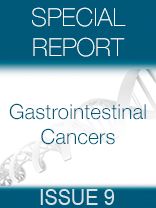SIRT Added to First-line Chemo Improves Response in Colorectal Cancer
Adding selective internal radiation therapy with SIR-Spheres Y-90 resin microspheres to standard first-line chemotherapy significantly increased hepatic depth of response in patients with metastatic colorectal cancer.
Volker Heinemann, MD

Volker Heinemann, MD
Adding selective internal radiation therapy (SIRT) with SIR-Spheres Y-90 resin microspheres to standard first-line chemotherapy significantly increased hepatic depth of response (DpR) in patients with metastatic colorectal cancer (mCRC), according to an analysis of the phase III SIRFLOX trial presented at the 2016 World Congress on Gastrointestinal (GI) Cancer.1
DpR may more exactly describe treatment outcomes following SIRT and forms the basis of a model that is predictive of progression-free survival (PFS) and response in patients with CRC and liver metastases, lead author Volker Heinemann, MD, explained at the GI Congress.
Heinemann discussed use of the Depth of DpR analysis, a methodology he and colleagues at the University of Munich formulated. According to Heinemann, DpR is a more exact way to assess efficacy that was observed to be associated with survival in the FIRE-3 and TRIBE studies.
“Oncologists have for some time observed that progression-free survival is not always a good predictor of overall survival for patients with metastatic colorectal cancer, as has been seen in some studies with biologic agents," Heinemann explained. "For this reason, in recent years we have seen an important surge of activity to find better surrogate markers for overall survival in mCRC, particularly regarding the effect of treatment on patients' depth of response.”
He explained that DpR analysis formed a volumetric model that was used in SIRFLOX to estimate the spherical liver tumor volume in each patient calculated from the measured length of up to 5 target liver tumors, which were selected in a blinded fashion during a central independent review of images taken at baseline and over the course of treatment.
DpR was measured by tracking tumor shrinkage until the nadir or maximal shrinkage was achieved. This model was also used to test the utility of DpR as a prognosticator of treatment benefit."We were able to complete this DpR analysis because the original SIRFLOX methodology included extensive radiographic data to determine response to treatment using traditional RECIST criteria. But that is the beauty of this methodology; when the right dataset is available we don't need any new information to estimate the volumes and shed potentially important new light on the original findings," said Heinemann.
SIRFLOX was a multicenter randomized controlled trial comprising 530 patients with nonresectable, liver-only or liver-dominant mCRC. Patients were randomized to receive first-line SIRT with SIR-Spheres Y-90 resin microspheres plus mFOLFOX6, with optional bevacizumab at the investigators’ discretion, or to a control treatment of first-line mFOLFOX6, with and without bevacizumab.
The overall median PFS was 10.7 months with SIRT versus 10.2 months in the control arm (HR, 0.93; 95% CI, 0.77-1.12; P = .43). The overall response rate (ORR) in the entire study population was similar between the arms at 76.4% versus 68.1%, respectively (P = .113).
However, outcomes were significantly improved in patients with liver metastases. In this group, the median PFS was 20.5 months in the SIRT arm versus 12.6 months the control arm (HR, 0.69; 95% CI, 0.55-0.90; P = .002). The ORR was 78.7% versus 68.8%, respectively (P = .042).
The data presented by Heinemann further supported the efficacy of SIRT in the hepatic mCRC population. According to Heinemann, median liver tumor volume was decreased from baseline by 75% with SIRT versus 68% with control, representing a 7% greater decrease with SIRT (P = .036). Time to response differed significantly between treatments by 60 days; deepest response, expressed as the median time to nadir, was seen at 266 days posttreatment initiation with SIRT versus 206 days with control (P <.001).
This treatment effect was more pronounced in patients with a greater baseline liver tumor burden; a predetermined statistical cutoff defined as >12% of the liver having been replaced by tumor was used to identify potential predictors of DpR.
In patients with a higher baseline liver tumor burden, the ORR was 80.2% with SIRT versus 67.2% with control (P = .022). The DpR was 77.5% versus 57.2% with SIRT versus chemotherapy, respectively (P = .003). Time to DpR was also extended by 3 months in this cohort; the median DpR was 298 days versus 196 days with SIRT versus chemotherapy, respectively (P = .001).
In patients with ≤12% tumor burden the median ORR was 84.7 % with SIRT and 83.5% with FOLFOX (P = .8). DpR was 72.5% versus 80.6% (P = .763), and the median time to nadir was 243.5 versus 220 days in the SIRT and chemotherapy arms, respectively (P = .152).
However, patients with a smaller baseline liver tumor burden of ≤12% were more than 6 times more likely to achieve complete response (CR) following SIRT compared with patients receiving only chemotherapy; CR was achieved by 11.3% of SIRT patients versus 1.7% of chemotherapy patients (P = .003).
PFS was significantly prolonged by 14 months in patients with >12% hepatic tumor burden receiving SIRT compared to control; median PFS was median 27.2 versus 13.1 months (P = .003). PFS in patients with lower liver tumor burden was 15.1 versus 12.2 months with SIRT and control, respectively (P = .112).
“The greater depth of response and time to maximal response following SIRT, together with the prolonged PFS in the liver, are very encouraging and increase our anticipation for the survival data we hope to see in 2017," Heinemann said.
References
- Heinemann V van Hazel GA Sharma NK, et al. Evaluation of depth of response within a volumetric model in patients with metastatic colorectal cancer: results of the SIRFLOX study. Presented at: 2016 World Congress on GI Cancer; June 28 - July 2, 2016; Barcelona, Spain. Abstract O-014.
- van Hazel GA, Heinemann V, Sharma NK, et al. SIRFLOX: randomized phase iii trial comparing first-line mFOLFOX6 (plus or minus bevacizumab) versus mFOLFOX6 (plus or minus bevacizumab) plus selective internal radiation therapy in patients with metastatic colorectal cancer.J Clin Oncol. 2016;34(15):1723-1731.

Survivorship Care Promotes Evidence-Based Approaches for Quality of Life and Beyond
March 21st 2025Frank J. Penedo, PhD, explains the challenges of survivorship care for patients with cancer and how he implements programs to support patients’ emotional, physical, and practical needs.
Read More